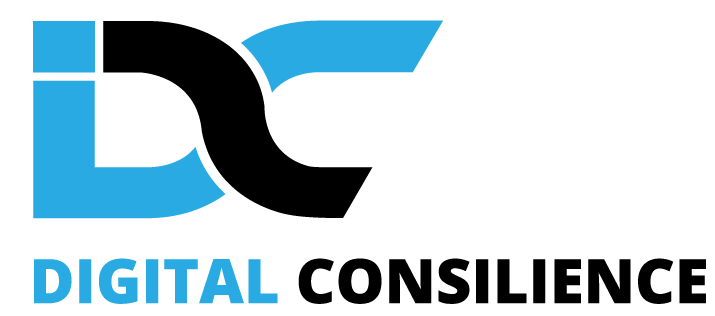Not all visitors to your website are created equal.
Some already have their credit card in hand and are prepared to make a purchase, while others are looking to compare different options. Then there are those only looking for general information and may not be in the market for your product or service at all.
Naturally, you want website traffic that supports your SEO objectives, and so when considering your keyword and content strategy, it’s important to consider the search intent of each keyword. If you ignore it, your website could receive thousands of irrelevant, low-quality visitors.
Every action you execute, from topic generation to content optimization, must be in line with the objectives and expectations of your target audience, this is particularly true when it comes to keyword research.
Implementing an intent-based strategy for your SEO and content efforts will help you understand and target your audience with pieces of content that satisfy their search intent.
This all starts with understanding the different types of search intent and which keywords align with the various types.
So, what are the different types of keyword search intent?
- Informational keywords — general information or answers to questions
- Navigational keywords — trying to find a specific website or page they already know
- Commercial keywords — deeper research, compare/contrast, looking for deals
- Transactional keywords — ready to convert or perform an action
The Four Types of Keyword Search Intent
Let’s dive a little deeper into the four basic types of intent when determining a user’s motivations for conducting a search: informational, navigational, commercial and transactional.
Informational Search Intent
Informational intent searches have a low action intent compared to transactional or commercial queries, and usually occur when someone is searching for general information or to answer a specific question.
However, this doesn’t mean they shouldn’t be a part of your keyword strategy. They are useful in establishing your brand as a leader in the industry, one that people turn to when they need advice or have a general inquiry in your field.
Developing this type of content can help your website build domain authority, earn valuable backlinks and boost brand exposure for when those readers are ready to take the next step.
Informational query examples and pages that rank for them:
- What do bed bugs look like? – Orkin
- What is there to do in London? – The Crazy Tourist
- How do I create a YouTube video? – Tech Smith
Informational keyword examples and pages that rank for them:
- hot springs in colorado – Colorado National Park Trips
- difference between alligator and crocodile – Captain Jack’s Airboat Tours
- best way to attract customers online – Forbes
In answer to this type of query, Google will compile a search result page with websites it feels will best answer the question with the least amount of effort.
When possible, search engine results pages (SERPs) tend to include content that answers the question directly on the results page, without the need to click over to the website. Formatting your content to appear in knowledge panels, carousels, featured snippets and infoboxes can help increase your chances of ranking for these terms.
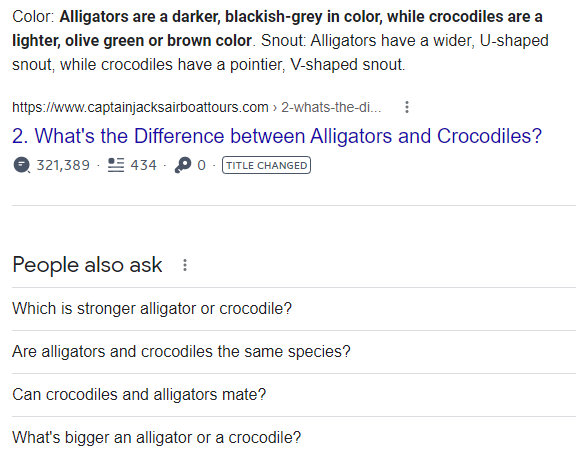
Search result for “different between alligators and crocodiles.”
Navigational Search Intent
Navigational search occurs when someone already knows the brand or product they are looking for and just wants to find the proper page to access it. Obviously your branded keywords come into play here and building general brand awareness through all your channels can make this an increasingly useful source of traffic.
Navigational intent keyword examples:
- FROSCH Travel website
- Where is the first Summit coffee located?
- LinkedIn login
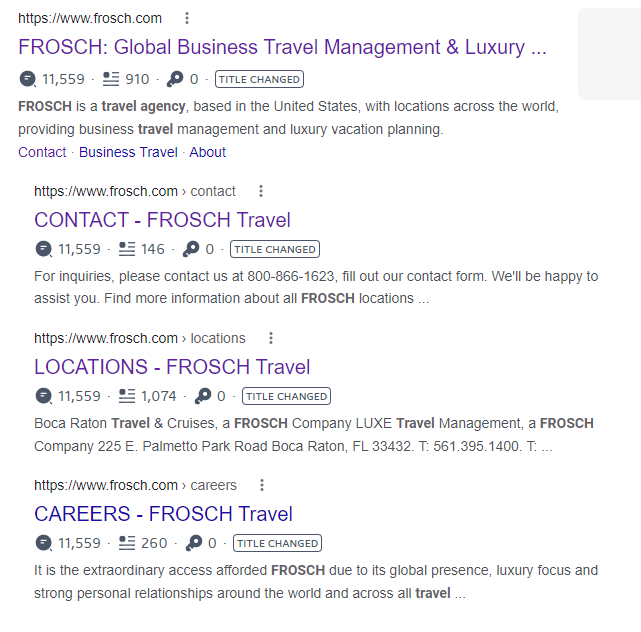
A search result page for the navigational intent keyword, “FROSCH Travel website.”
As long as your website has good technical SEO health and mentions your brand or product name on all relevant pages, there is normally no need to perform further optimization for navigational keywords.
Although you may need to work on optimizing your website for navigational keywords if you have the same brand name as another company, or if your brand name also refers to a place, physical object or service type.
Examples of real company names that might require navigational optimization work:
- Memphis Riverboats
- Destination Weddings
- Frozen Lemons
Commercial Search Intent
Searches containing keywords with a commercial intent usually happen during the “consideration phase” of the customer journey. People may use these searches to confirm their purchase decision, compare the product to similar products, or search for offers or discounts.
Commercial intent keyword examples and the pages that rank for them:
- best Chicago river boat tour – Time Out
- cheap hotels – Kayak
- Samsung or Apple – Creative Bloq
- tours in Charlotte – Charlotte’s Got a Lot
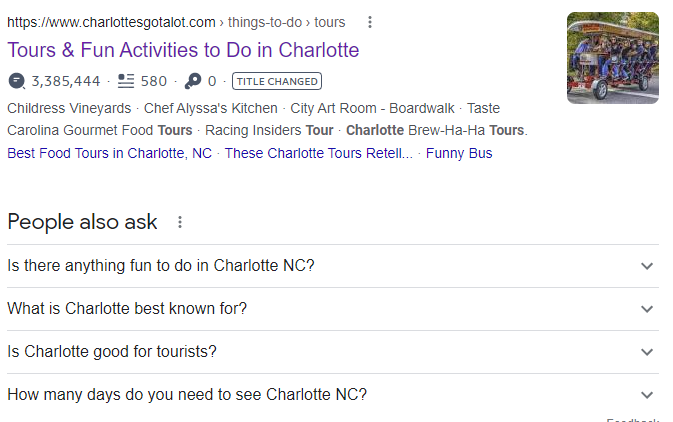
Search result page for the commercial intent keyword, “tours in Charlotte.”
Keep in mind that brand names might appear in commercial keywords just like they can in navigational ones, but since they aren’t searching for a specific page on your site, they aren’t considered to have navigational intent.
Depending on the particular keyword, you can use comparative pieces, listicles, reviews, or how-to blog posts to target these terms.
Transactional Search Intent
Transactional intent keywords are those with the strongest desire to make a purchase or take immediate action. These searches usually take place after the potential customer has performed their research and has entered the “purchase/decision” phase of the customer journey.
The best suited content types for targeting these keywords are pages where the user can immediately take the desired action: landing pages, subscription pages, and product or service pages.
Transactional intent keyword examples and the pages that rank for them:
- coffee shop near me – Main Street Coffee (I am located in Huntersville, NC)
- boston red sox women’s sweatshirt – MLB Shop
- Hawaii family vacation packages – Hawaii
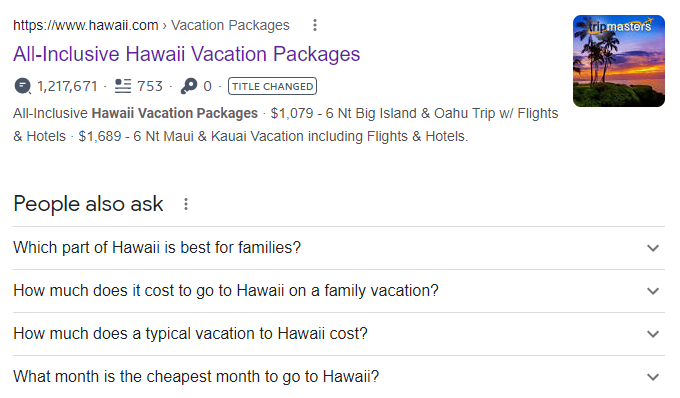
A search result page for the transactional intent keyword, “Hawaii family vacation packages.”
Common modifiers for these keywords are those like “near me,” “discount,” and “for sale,” and are usually more long-tail (high specific) in nature, such as the same above “boston red sox women’s sweatshirt for sale.” As you can imagine, this is also where local SEO optimization becomes very important.
A Quick Summary of Next Steps
Understanding that different keywords have different search intents behind them is the first step in building a successful keyword strategy.
The next step is auditing your existing content and determining which pages align with the various types of search intent. This is also when you will be able to determine where your existing content falls short, overlaps or where you have gaps that need to be filled with new content.
Once you have that in place, you can perform keyword research for each page, filtering for the proper search intent type and other relevant keyword factors.
With your keyword sets in hand, you can then go through and optimize each piece of existing content for the target keywords using SEO best practices and create a development schedule to create any missing content pieces.
Don’t forget to keep an eye on the proper metrics for each page so you can measure your success. In addition to tracking your ranking for each of the target keywords, you may also wish to measure relevant organic traffic for informational and commercial intent pages. For content with a transactional intent, you’ll also want to track total traffic, traffic source and conversions.
Remember that SEO takes time to mature, so don’t be discouraged if you don’t see immediate results.
If all of this seems like more than you want to deal with, don’t worry, we have you covered! Contact us using the form below for a free consultation.
Lance Harrell, Owner/SEO Specialist
